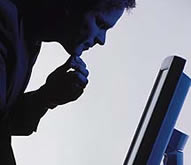Computerized
Family
 |
Do-it-Yourself
PC Tune-up
by Natalie Walker Whitlock, the
"Dot-Com-Mom" |
Just like cars, computers
need regular maintenance to stay in tip-top shape. A tune-up will
help keep your PC running at maximum speed and efficiency.
According to PC World, the
top five PC complaints are: slow speed, system crashes, freeze-ups,
slow boot up, and slow shut down. All of these can be improved
or even eliminated with a little regular maintenance.
One simple way to check
for problems and correct them is to use the ScanDisk utility included
with your operating system. Primarily, ScanDisk repairs errors
on your hard drive that occur when your computer gets shut down
improperly, whether accidentally or because of freeze-ups.
First, click the Start button.
Go to Programs, then Accessories, then System Tools and click
on Scan Disk. Click the drive you want to scan, choose either
the Standard or Thorough test and click Start. I recommend the
Standard for starters, as the Thorough test has numerous options
and takes f-o-r-e-v-e-r. ScanDisk will look at all the files on
the selected disk and repair any problems it finds. When finished,
it will display a dialog box listing any problem files it found
and the action it took to correct those files. It will also ask
you if you would like to save the questionable data. Unless you
know you're missing some files or programs, just choose the delete
option.
After scanning the next
step in our tune-up is to defragment. Defragmenting your hard
drive removes unnecessary spaces and enables the information to
be accessed more efficiently. Remember to shut down all programs
before starting as they may cause the defragmenting process to
constantly re-start. Go to Programs, then Accessories, then System
Tools and click on Disk Defragmentation (called Disk Defragmenter
in XP). Depending on how long it's been since you last defragged,
and what your drive's capacity is, be prepared to wait a while!
The next step is Disk Cleanup.
Cleanup will rid your PC of the numerous temporary files (including
temporary Internet files) generated during normal operation that
clog up your hard disk. Click on Start, then Programs, Accessories,
System Tools, and finally Disk Cleanup.
Updating your software can
help your programs run more efficiently -- especially your operating
system. Fortunately, OS software updates are freely available
on the Windows update site. You can easily get to the Windows
Update Web site by clicking Start, then Windows Update, (or Start,
Settings, Windows Update, depending on which Windows version you
are running). Once on the Windows Update site, click on Product
Updates. The site is set up to automatically check your computer
and determine which updates your system needs. You simply apply
a check the box next to the updates you wish to perform, then
click the big Download button. It may be necessary to do this
more than once, since you can not perform multiple updates. (Note:
you may want to do this before you defragment, as your system
files may be a mess afterwards).
You can free up even more
disk space by manually deleting folders and programs you no longer
need (be careful here: if in doubt, make a backup before deleting).
Empty your recycle bin, and Use a "zip" type compression
utility to store infrequently used files in a folder labeled "archive."
If you want even more tools
for your do-it-yourself tune-up, try PC Pitstop (http://www.pcpitstop.com/pcpitstop/default.asp).
PC Pitstop runs diagnostics to identify what you can do to improve
your computer's performance. The process is easy, safe -- and
best of all, free. After the diagnostics run, you'll be given
a report on your PC's health and performance, as well as tips
for improving all kinds of things. The diagnostics take between
one and five minutes (depending upon your system and modem speed).
To use PC Pitstop you'll need a Windows operating system and Microsoft
Internet Explorer 4.0 or higher.
With a little regular maintenance,
your family PC can be a lean, mean, computin' machine!
Natalie Walker Whitlock is
an technology expert, Mom to seven, and author of the new book,
"A Parent's Guide to the Internet." As "Dot-Com-Mom"

